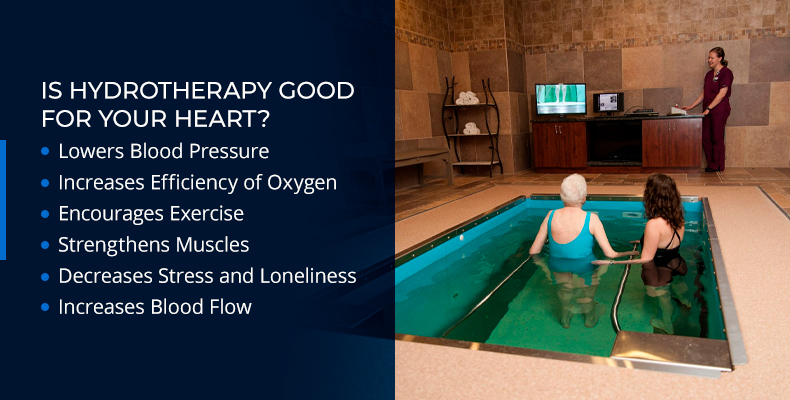Benefits of Aquatics on Heart Health
Heart disease emerged as the leading cause of death globally in the mid-1900s. Today, many nations are cutting this mortality rate through public health education. Most people now know the basics—smoking, physical inactivity, obesity and unhealthy diets harm their heart. At least 80% of premature deaths from heart disease and stroke can be avoided.
Heart disease is the leading cause of death for both men and women in the United States over the age of 65. Our heart is the most important muscle, and exercising helps control or reduce any risk factors that can lead to heart disease. Here are a few of the most common risk factors:
- High blood pressure
- Obesity
- Diabetes
- Physical inactivity
- Stress
Exercise and Heart Health
A sedentary lifestyle can be a risk factor for cardiac events. An exercise program or regular movement can address all of the risk factors listed above, but beginning an exercise or movement routine for the active aging population can have some challenges, such as:
- Pain with movement
- Fear of falling or getting hurt
- Not knowing what to do
- Lacking confidence
General guidelines for exercise include 30 minutes of aerobic exercise at least five days a week. Some resistance training is also recommended to help tone muscles and build endurance. However, patients’ heart health can make moving or motivating themselves to go to the gym difficult.
With hydrotherapy, patients can achieve aerobic and resistance exercise. Water creates resistance as someone walks through it, all while supporting the limbs and reducing pain.

Is Hydrotherapy Good for Your Heart?
In short, yes! Aquatic programs, swimming, water walking and water immersion can help the active aging community embrace exercise and decrease risk factors associated with heart disease.
Below are some of the primary effects of aquatic therapy on the heart.
Lowers Blood Pressure
Repeated workouts in the pool can lower blood pressure by reducing the hardening of the blood vessels, which is the prime factor that drives increased blood pressure as we age.
Increases Efficiency of Oxygen
Blood pressure automatically decreases with water immersion. The heart can relax because the water’s hydrostatic pressure supports and increases blood delivery throughout the body. This delivers increased oxygen and nutrients to our brain and increases mental sharpness, clarity and memory.
Encourages Exercise
The buoyancy of the water makes exercising pain-free and more comfortable on the joints, eliminating the risk and fear of injuries or falls for older adults when being active. This environment can help overweight, inactive participants gain the confidence to begin and maintain a wellness plan.
Strengthens Muscles
Whether choosing to swim, take a class or just walk, water creates both an aerobic and resistive environment, allowing patients to maximize their workout.
Decreases Stress and Loneliness
Recent studies show that social isolation and loneliness increase women’s risk for cardiovascular disease by 13-27%. Stress can also be a contributing factor. Exercising, joining a fun aquatic class or joining a pool with a walking program can be a great way to strengthen the heart and create new friendships.
Increases Blood Flow
Increased blood flow while immersed in water improves the blood vessels’ ability to dilate, lowering blood pressure over time. And like any muscle, the heart gets stronger with increased work.
Incorporating Aquatic Therapy into Cardiac Rehabilitation
Cardiac rehabilitation is a recovery option that allows cardiac patients to exercise safely under supervision, while being educated on the importance of physical activity, lifestyle changes, and how to prevent future heart disease complications. Early interventions often focus on the following goals:
- Reducing resting and exercise heart rate
- Decreasing resting and exercise blood pressure
- Reducing myocardial oxygen demand during activity
- Expanding plasma volume
- Enhancing glucose tolerance and improving lipid levels
- Weight loss
- Stress reduction
- Exercise and education
Committing to a new lifestyle, such as adding in a regular exercise program, can be challenging for anyone. Often, cardiac patients do not feel well, are among the older population, have been sedentary, and are fearful of exercise. Additionally, they often display other comorbidities like obesity, arthritis, diabetes, COPD, and chronic pain. Exercise is a critical component to reduce the risk of cardiac patients having another cardiac event, and water can be the solution to helping them comfortably and effectively become fit while taking back their lives.
How Can Aquatic Therapy Support Cardiac Rehab?
- Adds both postural support through buoyancy, yet resistive forces while working on exercises, walking, and range of motion.
- Reduces pain and soreness due to activity by offloading the participant’s actual weight through different levels of immersion.
- Increases the duration of exercise because of comfort and tolerance.
- Provides a safe environment for patients to be challenged through exercise, while remaining free from the concerns of common land-based injuries.
- Hydrostatic pressure aids in the physiological effect on the cardiac, venous, and lymphatic systems, decreasing the stress placed on these systems while exercising.
Next time you see a pool or have the chance to take a dip, jump in! Exercise, especially in a pool, can be a fun, pain-free and powerful tool to help you achieve the best version of yourself at every age.
Find a HydroWorx Hydrotherapy Pool Near You
Exercise, especially in a pool, can be a fun and powerful tool to help users achieve the best version of themselves at every age.
For a controlled hydrotherapy experience with a personal trainer or fitness instructor, check out a facility near you that holds one of our pools.

